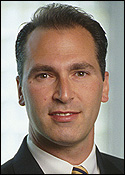Jul 27, 2004Making its long-awaited move into the RFID market with a bang, Symbol Technologies, the world's largest provider of portable data terminals and bar code scanners, will acquire Matrics, a manufacturer of RFID readers and tags based on Electronic Product Code (EPC) standards.
Symbol will pay $230 million in cash for the privately held Rockville, Md., company in a deal that is expected to close in the third quarter of 2004.
The deal jumpstarts Symbol’s efforts to offer RFID products to its huge customer base, and the company believes that the combination of Symbol and Matrics would create a large-scale, established RFID company that could help speed the uptake of RFID.
"For some companies, this deal could be the tipping point for them to move beyond an ROI model and into full deployment," says William Nuti, the president and chief executive officer of Symbol, which is based in Holtsville, N.Y.
For such a large player in the bar code world, Symbol had been quiet about its RFID aspirations, leading some commentators to suggest its role would be limited to being an RFID reseller. Nonetheless, Symbol had indicated it was planning to provide a complete data collection infrastructure, including handheld and fixed RFID readers, wireless access points and software that integrates RFID and bar code data and passes it to enterprise systems. Now, with the acquisition of Matrics, the company says it will offer a complete range RFID equipment and integration services from tags and readers through network architecture.
Previously, however, Symbol had stated it had no intension of moving into the tag manufacturing market; now it believes that Matrics’s tag business will be key to the success of the acquisition because customers will want to buy complete systems from a single supplier. "We need to offer an end-to-end system. We will be in the tag business because our customers require us to be in that business," Nuti says.
Symbol believes that its worldwide sales channel and customer base that use its equipment will provide a ready market for its planned products based on Matrics’s technology. The company also believes that it can apply its experience in developing and delivering a range of offerings related to a new technology in order to boost customer acceptance and deployment of RFID.
"The development of Wi-Fi showed that when there is a new technology and new standards, there has to be strong innovation at both ends of the technology and there is a lot of innovation work still to be done with tags and the readers [in RFID]," Nuti says.
Matrics’s current products consist of read-only and read/write EPC tags, multiprotocol, EPC-compliant fixed readers and RFID reader antennas, as well as readers designed to be embedded into printers or mobile devices. Mobile devices also make up a key part of Symbol’s existing bar code reader business. Prior to today’s acquisition announcement, Symbol had said it would introduce its first RFID product—basically an RFID reader embedded in MC900 mobile computer and capable of reading tags based on the Class 1 EPC standard—at the EPCglobal US Conference 2004 in September.. Symbol had also said it was also developing fixed readers that would be released some time next year.
Symbol says the deal to purchase Matrics, which took around three months to put together, will give Symbol the opportunity to build on Matrics’s existing mobile reader offerings as well as further develop system integration capabilities for prospective customers.
"Matrics was the furthest along of any of the companies we looked at with respect to dealing with hard technical issues [such as the ability for readers to read tags accurately] and systems integration," says Nuti.
Symbol intends to finance the acquisition with short-term borrowings. As a result of the acquisition, Symbol expects the dilution to its 2004 earnings per share to be in the range of 5 to 6 cents per diluted share. It expects the dilutive effect to diminish in 2005, subject to timing and market demand for RFID products.


